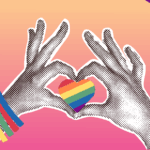Supporting employees and cultivating compassion for LGBTQIA+ employees beyond June
By Paul LaFleur, Design Director, Hook
The cosmos knew well before I did that being gay was written in the stars. Having been born on June 28th—Christopher Street Liberation Day and the anniversary of the Stonewall Riots—I am intimately aware that from the 1st of June through month’s end, agencies roll out the rainbow-clad carpet in an effort to make employees like myself feel loved and supported.
Which is very much appreciated and necessary, of course, but there are eleven other months in the year where that love and support is needed just as much–if not more. We need words and actions, all year long.
Making donations to LGBTQIA+ charities and organizations, hosting speakers and educational forums, and spotlighting the work of artists and industry members alike are all actions worth taking. But there’s one more action which isn’t discussed enough: And that’s providing written and verbal permission to your employees to be their authentic, total selves in the workplace.
Not a sanitized, watered-down version of themselves. We’re talking about the incredible ability to be the same person inside and outside of work.
This may sound odd at first and you may be asking, “who wouldn’t be themselves?” Or perhaps you think it’s weird that I’m suggesting that you give permission to adults, who, truth-be-told, shouldn’t need your permission. But according to a recent Human Rights Campaign report, 46% of all LGBTQIA+ employees are still closeted at work.
That means that nearly half of your LGBTQIA+-identifying staff have felt the need to censor themselves and pull back from conversations or simply don’t feel that they are able to freely contribute, for fear of judgment or retaliation or even that they may lose or damage relationships at work–if not worse.
It shouldn’t be this way. Pause… it can’t be this way anymore. We need to fix it.
When I was first starting out in my career, I wasn’t one to raise my voice to share ideas and experiences that may very well have changed client work for the better or solved a problem that was more evident to myself compared to my heterosexual peers. I held back as a gay male.
I was fearful to ruffle feathers, fearful of being seen as different and scared that my value may be undermined. “Don’t buck the status quo and upset the powers that be,” rang through my head.
Looking back, that wasn’t really me. If I could do it over again, I’d know that being myself was the best thing I could be.
I wasn’t ashamed of who I was, but I was concerned that who I was could negatively impact my career growth and was concerned that others might be ashamed of me or my opinions. For too many years this was my line of thinking.
Fortunately, I eventually found myself surrounded by a group of leaders in an organization that radically changed my way of thinking and which encouraged me to work authentically.
Our global CEO was gay, our U.S. president, CMO and CGO, among others, were amazing women of diverse backgrounds. But more importantly, they all lived authentic, unapologetic lives inside and outside of the agency. To see that openness and to be given that permission to live truthfully no matter who you were or how you identified was an amazingly freeing moment. Even more so because it came from the top.
That’s what c-suites and people in positions of power everywhere need to learn. You can take practical, powerful action by letting your employees know that they are supported and encouraged to be their full selves at work every day of the year. Say it outright and say it emphatically.
Tell them in no uncertain terms that you see their diversity as a positive, that you believe their thoughts and feelings are valid and that their personal experiences are welcomed. It’s not your employees’ responsibility to ask for permission. It’s your responsibility to give it and to give it freely. To be given permission to live openly is a priceless gift that not everyone receives.
Now before you get HR to fire off an email with a subject line of “Permission to be…,” and a rainbow heart emoji, let’s take a beat. An email blast isn’t a quick-fix, and words must be followed with actions, conversations and dialogue–lots of dialogue.
Don’t expect everyone to “out” themselves once permission has been given. What comes next will be an earned exercise in trust–hence the importance of it being a focused, year-round priority.
The more you build up that opportunity for compassion, the more your employees will hopefully dispel their fear, unease and uncertainty. Ask yourselves if you’re doing things that offer opportunities for them to feel welcomed, to feel included, to feel open. If not, ask them how you can do better.
Do you actively engage with them through employee resource groups or DE&I committees? Is your agency publishing numbers on LGBTQIA+ diversity statistics and making a concerted effort to improve? Are you having open, frank discussions with clients about helping to elevate their work for the community outside of Pride? Are you even engaging with your clients about this community at all? If not, ask yourselves “why?” Is it a matter of fear, comfort, or just a desire to not rock the boat?
Then remind yourself that it’s the responsibility of agencies to put thought-provoking, conversation-shifting, respectful work into the world. Remember that brands come to you and your teams to dream up, design and deliver the very things that help them communicate with people everywhere.
At Hook, the JEDI (Justice, Equity, Diversity, Inclusion) Group that I’m a part of recently launched an effort called “Ask a JEDI”–an endeavor where any one from the agency can get a second set of eyes or a gut check on how to make sure our work is as inclusive as possible. If we as a collective make the effort to fight for more diverse casting and vendor partnerships during shoots or an inclusive headline on a billboard, then hopefully that compassion and support is also seen by the 46% who need it most.
Lastly, this shouldn’t need to be said, but I’ll say it loud enough for the people in the back of the room: This same approach and level of effort should be top of mind when it comes to gender diversity, racial diversity, neuro diversity, disability diversity and the like.
Commit to making your agency a place where people from all walks of life, disciplines, levels and experiences promote a cultivated compassion year-round for each other. My hope is that with these actions in mind, we can get to a place where every single human is proud of who they are in and out of work–no matter their diversities.
Happy Pride, 365.








